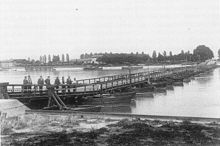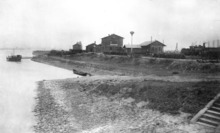Rosengarten station
| rose Garden | |
|---|---|
|
Rosengarten station (photo taken around 1881)
|
|
| Data | |
| Design | Terminus |
| opening | June 1, 1869 |
| Conveyance | November 30, 1900 |
| location | |
| City / municipality | Lampertheim |
| country | Hesse |
| Country | Germany |
| Coordinates | 49 ° 38 '3 " N , 8 ° 23' 0" E |
| Railway lines | |
| Railway stations in Hessen | |
The station Rosengarten was from 1869 to 1900 the right bank of the station of Worms (now Rhineland-Palatinate ), however, on the one district of the current city Lampertheim (today's State of Hesse located). It was built by the Hessian Ludwig Railway.
topography
From Worms - at that time one of the largest cities in the Grand Duchy of Hesse - the state capital Darmstadt could initially only be reached by train with a detour via Mainz . Since a railway bridge over the Rhine near Worms could not initially be financed, the hamlet of Rosengarten , now a district of Lampertheim, on the opposite side of the Rhine from Worms, was chosen as the destination for the railway lines on the right bank of the Rhine towards Worms .
Railway lines
These routes, aiming at Worms and ending in the Rosengarten station, were:
- Riedbahn : Darmstadt – Rosengarten , from June 1, 1869
- Bensheim – Rosengarten , from November 1, 1869
- Lampertheim – Rosengarten , from October 15, 1877, continued to Mannheim-Neckarstadt on October 15, 1879
All lines were introduced into the station on a single track . There was also the Worms – Rosengarten trajectory , which led to the Worms-Hafen station on the left bank of the Rhine , from where passenger trains ran to Worms main station and freight trains.
railway station
Railway systems
The station was about 750 meters long and had twelve track axes, two tracks were on platforms , the station itself directly on the banks of the Rhine. Pedestrians and passengers traveled to and from Worms via a ship bridge , and the Worms – Rosengarten trajectory was used for freight traffic and had its own access track. The station had all the facilities of a large terminus and terminal station : loading ramp, goods hall, weighbridge , loading gauge , turntable , engine shed and coal store. In addition to ferry traffic, there was an additional landing stage on the banks of the Rhine for shipping.
The flooding of the Rhine repeatedly caused damage to the railway systems , so that operations had to be temporarily suspended.
Reception building
The reception building also had all the facilities of a large terminus and terminal station: first, second and third class waiting rooms , restoration and a princely pavilion . This was among other things during visits of Kaiser Wilhelm II. In Worms on December 9th, 1889, of the Russian Tsar Nikolaus II. On October 7th, 1899 and at the inauguration of the Ernst Ludwig Bridge , a road bridge over the Rhine, on March 26th 1900 , used by Grand Duke Ernst Ludwig of Hessen-Darmstadt . This road bridge, built right next to the ship bridge and the train station, replaced the ship bridge. In addition to the reception building, the station also had houses with officials' apartments.
traffic

The passenger traffic at the Rosengarten station was considerable. In 1880 12 pairs of trains drove to Rosengarten every day, in 1897 there were 15 pairs of trains. In freight transport, a pair of freight trains drove daily on each of the three routes to and from Darmstadt / Frankfurt am Main , Lampertheim / Mannheim and Bensheim . For the subsequent trajectory, the figures for the crossed cars are available: in 1886 there were 39,537, an average of 108 cars per day.
The End

The very complex, cumbersome and slow trajectory traffic was not up to the traffic volume.
In the course of straightening the Rhine and based on military considerations, planning began to bridge the Rhine near Worms from 1890 onwards. On November 3, 1894, the state and the Hessian Ludwig Railway signed a contract for the construction of the bridge, in which the demolition of the Rosengarten station was already planned after the bridge was put into operation. It was opened on November 30, 1900 by the Prussian-Hessian Railway Association , which had since taken over the operation of the Hessian Ludwig Railway . The lines on the right bank of the Rhine to Worms were led to Worms , now Worms main station , with the new bridge . This made the Rosengarten station superfluous. On December 1, 1900, freight traffic was discontinued there, the railway maintenance service was dissolved at the end of the year and passenger traffic was discontinued on January 2, 1901. The station building was already auctioned on February 9, 1901. The railway systems were completely removed, so that structural traces can no longer be seen today.
Worth knowing
- In 1910 a stop with the same name Rosengarten was set up elsewhere on the Weinheim – Worms railway line.
- The demolition material from the station building was used, among other things, to build a café with a dance hall in Obrigheim , which was given the name Rosengarten .
literature
- Ralph Häussler: Railways in Worms . Hamm / Rheinhessen, 2003.
- Hans Heim. The Worms ship bridge and the Rosengarten station . In: Lampertheimer Heimatblätter 104 (2000), pp. 1–2.
- Magistrate of the City of Lampertheim (Ed.): Rosengarten. Contributions to the history of the Rosengarten community - on the 40th anniversary of the Rosengarten community . Lampertheim 1977.
- Fritz Paetz: Data collection on the history of the railways on the Main, Rhine and Neckar . Bensheim-Auerbach 1985, p. 47ff.
Web links
Remarks
- ↑ The recording is from October 7, 1899 (see: Häussler, p. 34). In the background you can see the construction site with the still scaffolded eastern tower of the Grand Duke Ernst Ludwig Bridge (today: Nibelungen Bridge ), which was inaugurated in March 1900.
Individual evidence
- ^ Heinz Schomann : Railway in Hessen . Railway buildings and routes 1839–1939. In: State Office for Monument Preservation Hessen (Ed.): Cultural monuments in Hessen. Monument topography Federal Republic of Germany . Three volumes in a slipcase. tape 2.1 . Theiss Verlag, Stuttgart 2005, ISBN 3-8062-1917-6 , p. 19th ff . (Route 001). P. 351.
- ↑ §§ 5ff. Agreement between the Grand Duchy of Hesse and HLB dated November 3, 1894 on the extension of railway facilities . In: Eisenbahndirektion Mainz (Hrsg.): Collection of the published official gazettes . Born in 1897, p. 43ff.
- ^ Eisenbahndirektion Mainz (Ed.): Collection of the published official gazettes of January 5, 1901. Volume 5, No. 1. Announcement No. 5, p. 3 and: ibid. Of January 19, 1901. Volume 5, No. 3., Personal-Nachrichten, p. 14.
- ↑ Eisenbahndirektion Mainz (Ed.): Collection of the published official gazettes from December 1, 1900. Volume 4, No. 55. Announcement No. 529, p. 410.



